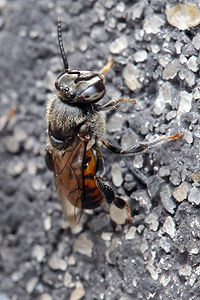
Photo from wikipedia
Honey has recently been rediscovered as an antibacterial and wound-healing natural product. The medicinal properties of honey originate from the floral source used by bees. The objective of the current… Click to show full abstract
Honey has recently been rediscovered as an antibacterial and wound-healing natural product. The medicinal properties of honey originate from the floral source used by bees. The objective of the current study was to evaluate the antimicrobial activity of Sudanese crude acacia bee honey and its solvent extracts regarding its biological activity and chemical characterization. To verify the nature of the antibacterial agent(s) of honey, sample (A) Sudanese crude unprocessed acacia bee honey obtained from west of Sudan (Nyala) during October 2019 was tested in vitro for antibacterial activity against 10 standard microorganisms Enterobacter aerogenes: ATCC: 13048, Enterococcus faecalis: ATCC: 29212, Escherichia coli: ATCC: 25922, Klebsiella pneumoniae: ATCC: 700603, Pseudomonas aeruginosa: ATCC: 27853, Serratia marcescens: ATCC: 8100, Staphylococcus aureus: ATCC: 29213, Staphylococcus epidermidis: ATCC: 12228, Staphylococcus Methicillin Sensitive MSSA: ATCC: 29213, and Staphylococcus Methicillin-Resistant MRSA: ATCC: 23591. Extraction of honey sample was carried out by petroleum ether followed by ethyl acetate using liquid/liquid extraction technique, using separating funnels. All organic extracts in addition to their aqueous residue were tested in vitro for antibacterial activity against the10 standard microorganisms. Ethyl acetate extract was subjected to gas chromatography-mass spectrometer (GC-MS) for chemical characterization. Sudanese crude unprocessed acacia honey showed inhibitory effects against the 10 standard microorganisms. Petroleum ether extract showed no antibacterial activity against the tested organisms, while its water residue exhibited remarkable activity. The ethyl acetate extract exhibited strong antibacterial activity against the tested organisms, while its aqueous residue showed no activity. Ethyl acetate extract subjected to gas chromatography-mass spectrometer (GC-MS) showed twenty-one chemical constituents. The GC-MS showed twenty-one chemical compounds, and phenolic compound was the highest concentration. Ethyl acetate extract exhibited strong antibacterial activity which can be formulated as topical dressing for wounds and burns. The usage of honey in a professional context should be taken into consideration while treating burns and wounds.
Journal Title: BioMed Research International
Year Published: 2022
Link to full text (if available)
Share on Social Media: Sign Up to like & get
recommendations!